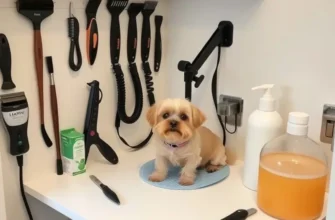Every loving pet owner understands the weight of responsibility that comes with caring for a furry family member. In addition to regular feeding, exercise, and healthcare, it’s equally vital to prepare for emergencies that could affect both pets and children in your rental apartment. Natural disasters like fires, earthquakes, or even unexpected health emergencies can happen, making it essential to have a clear pet emergency plan that suits your lifestyle. This plan fosters a sense of security and ensures everyone knows what to do in a crisis. This guide aims to provide families, pet owners, couples, and renters with practical, actionable steps to create effective pet emergency plans that keep everyone safe and calm even in stressful situations. With a bit of forethought and organization, you can turn concerns about pet safety into a proactive and reassuring strategy, ensuring that your apartment remains a loving, secure environment for all inhabitants.
Assessing Potential Risks: What to Prepare For

Understanding the unique risks in your apartment living scenario is crucial for crafting a robust pet emergency plan. Begin by examining the geographical and structural aspects of your residence. Is your apartment located in a flood zone, wildfire area, or earthquake-prone region? Elevate your awareness of these environmental hazards, as awareness is the first step in preparedness.
Knowing your building’s infrastructure can also help. Older buildings might lack modern safety features, while high-rise apartments may present additional evacuation challenges during an emergency. It’s wise to familiarize yourself with all emergency exits and routes—practice them regularly so that you and your pet can navigate them under pressure.
Another dimension to consider are the specific challenges pertinent to pet owners in rental properties. Allergies can present a significant risk, for both your pet and any other tenants. If your pet has specific allergies, ensure your emergency supplies are free from potential hazards.
Consider mobility constraints, too. If you or your pet have difficulty moving, prepare strategies that accommodate these limitations. This could include storing emergency supplies in easily accessible locations or investing in pet-specific mobility aids. For pets with special needs, maintain an up-to-date file of their medical history and ensure it’s easily reachable.
In rental living, space constraints pose another challenge. Store your emergency kit cleverly, utilizing vertical space or under-used areas such as under beds or in closets. When compiling your kit, include essentials like water, pet food, medications, and sanitation supplies. Ensure there’s enough for at least 72 hours. To complement this, consider renter-friendly storage solutions that can keep emergency supplies organized and ready without infringing on your living space. Learn more about smart apartment organization techniques.
Creating a checklist of potential emergencies is a practical way to stay prepared. List down possibilities such as natural disasters, fires, chemical spills, and even power outages. For each scenario, outline clear strategies that suit your lifestyle, emphasizing flexibility and pragmatism. For example, if you live in an area prone to blackouts, a battery-powered radio can be a lifeline in staying informed.
Lastly, engage your community. Connect with neighbors who also have pets and collaborate on emergency planning. This network can provide mutual support and assistance during crises. Sharing knowledge and resources not only enhances preparedness but also strengthens community bonds.
Being methodical and proactive in assessing and addressing risks can transform your apartment into a safer haven for both you and your pet. As you develop your emergency plans, remember to iterate periodically, especially when circumstances or living environments change. Preparedness is an ongoing process, the more meticulous, the more empowering it becomes.
Building Your Pet Emergency Action Plan

Creating a pet emergency action plan is crucial for ensuring your furry companions are safe during any unexpected situations. Start by identifying individuals who can support you in an emergency. Designate reliable friends, neighbors, or nearby relatives as emergency contacts. It’s vital to ensure these individuals are familiar with your pets’ needs, including their medical conditions and behaviors.
Your next step is to organize the necessary supplies. Store them in a location that’s easily accessible in case of an evacuation. Ideally, these can be stored near the main entrance so that gathering them is seamless. Consider using labeled storage containers for clarity and organization. Include items like pet food, bowls, a leash, and a sturdy pet carrier. Don’t forget comforting items like a favorite toy or blanket to ease stress during transitions.
A comprehensive pet evacuation kit is another essential component. This kit should include important documents such as vaccination records and microchip information. Store these documents in a waterproof bag to protect them from damage. Ensure you’ve packed any medications your pet might need, along with clear instructions on dosage and administration.
Familiarize your pet with the carrier by allowing them to spend time in it prior to emergencies. This practice helps reduce anxiety when it’s time to evacuate. If safe apartment living is a priority, it might be beneficial to explore alternatives for ensuring your pet’s safety, such as apartment balcony safety netting. This could prevent accidents and injuries during stressful moments.
Communication is key during emergencies. Keep your emergency contacts updated on your whereabouts and inform them of any changes to your plan. It’s also a good idea to establish a communication method, such as a group chat, to facilitate swift and effective communication with all involved.
Practice your evacuation routine regularly with your pet, just as you would a fire drill. This helps both you and your pet become familiar with the process and identify any areas needing improvement. Observing how your pet reacts during these drills will also allow you to make necessary adjustments to enhance their comfort and safety.
Lastly, make a habit of reviewing and updating your emergency plan periodically. Changes in your living situation or your pet’s needs may necessitate adjustments to your plan. Staying proactive and adaptable is crucial for effective emergency preparedness, ensuring that you and your pet remain safe in the face of unforeseen circumstances.
Final words
By investing time into developing a pet emergency plan tailored to your family’s needs, you are not only ensuring the safety of your pets but also enhancing your overall peace of mind in your apartment. With clearly defined actions and necessary supplies at hand, families can face any challenge together. Remember, the cornerstone of preparedness lies in communication and practice. Regularly reviewing and simulating your emergency plan can make all the difference when it counts the most. Stay proactive, stay safe, and enjoy the peace of mind that comes from knowing your loved ones, pets and children alike are well-cared for.









